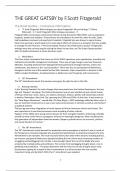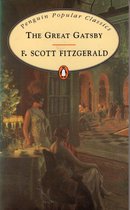THE GREAT GATSBY by F.Scott Fitzgerald
The Great Gatsby – Contextual Information
1. “F. Scott Fitzgerald: What intrigues you about Fitzgerald’s life and writing?” (“Selina
Ifidon.pdf - 1. F. Scott Fitzgerald: What intrigues you about ...”)
Fitzgerald often wrote about controversial themes during the period 1920-1950, such as psychiatric
hospitals, wealth and ambition. These themes are translated in his own life, when his wife, Zelda,
had breakdowns and went into psychiatric hospitals. Fitzgerald also was known to spend money
faster than earning it, which leads to his novel about effects of money on a character that was unable
to manage his own finances. (“The Great Gatsby Treasure Hunt Flashcards | Quizlet”) Fitzgerald’s
writings were also not very popular during the times he was alive, yet The Great Gatsby excelled
after his death and became a classic American novel.
2. World War 1
The three major innovations that came out of the WW1 experience were speakeasies, assembly line
methods and scientific management techniques. There was a huge change in post war American
Attitudes, including disillusionment (disappointment) particularly amongst veterans, artists and
intellectuals, also known as the ‘Lost Generation’. There was also an uprising fear of Bolshevism,
foreigners and the rise of the nativist Ku Klux Klan. However, major movements in America in the
1920s included Prohibition, Fundamentalism vs Modernism and Prosperity and Consumerism.
3. 19th Amendment
The 19th Amendment meant that women were given the right to vote in the USA.
4. Roaring Twenties
In the ‘Roaring Twenties’ the main changes that were pivotal was the Harlem Renaissance, the Jazz
Age and ‘Flappers’ emerging. The Harlem Renaissance was an was intellectual and cultural revival
of African-American music, dance, art, fashion, literature, theatre, politics and scholarship centred
in Harlem, Manhattan, New York City, spanning the 1920s and 1930s. At the time, it was known as
the "New Negro Movement", named after The New Negro, a 1925 anthology edited by Alain Locke. It
was an important movement as it saw a new social consciousness in America as well as commitment
to political activism.
The jazz age saw many integrations of same aspects of African American culture into Society. This
was important as it saw America become more accepting of other cultures.
Flappers of the 1920s were young women known for their energetic freedom, embracing a lifestyle
viewed by many at the time as outrageous, immoral or downright dangerous. Now considered the
first generation of independent American women, flappers pushed barriers to economic, political
and sexual freedom for women. ‘
5. The 18th Amendment.
The 18th Amendment strictly banned the production and consumption of alcohol.it was in result of
the Temperance movement (people who wanted total abolishment os alcohol) and was/is the only
Amendment to be repealed. The result was total destruction ofan entire industry including job loss,
tax revenue and general lawlessness (people breaking the law.) there were increasing numbers of
smuggling and bootlegging from Canada. It also brought about the rise of the Mafia who were
protected by crooked police and politicians. The income from bootlegging brought about a rise in
gambling and prostitution. ‘ The great depression and the mass loss of jobs brought about many
businessman signing for a repeal of the ist amendment in a bid to prevent the new socialist
movement rising, and by March 1933, the 1st amendment was repealed.
1
, 6. Prohibition
Speakeasy was a place where alcoholic beverages were illegally sold. This was common in America
during prohibition (1920 – 33). They were important in this time period as members of organised
crime viewed them as a way of making money through ownership and controlling the illegal liquor
trade.
7. Organised crime and Arnold Rothstein
Arnold Rothstein began between the law, known as a fixer’, someone who smoothed over rocky
relationships between criminals and those upholding the law. This interests me as he already
establishes himself as someone who was in between the law. In addition, Rothstein rigged most of
his gambling games, leading to his winnings and becoming a millionaire. This is important as he had
gone against the law to win his fortune, like many others during this time period, and yet never gets
caught. He also was one of the first involved with 'bootlogging' but it was profitable enough, showing
now the Prohibition was not as rebelled against as it seems. Finally, his overall personality shapes
many characters in plays and novels, as he was a typical narcotic during the 1920s.
8. Flappers.
According to the author, the most essential elements of being a true flapper are ‘poisonously’ scarlet
lips, richly ringed eyes, beauty and pallor morris (pale skin). Flappers also wore revealing clothing
that many in this time period saw as underwear. They also have their hair in a tight bob.
The photos by Louise Brooks clearly highlight the Flappers; they wore more revealing clothing, as
shown by low necklines in their dresses, and wore fur coats in the winter, as shown in the
photographs. The photos also show the typical Flapper hairstyle, a bob, accompanied by dark lips.
The photographs completely demonstrate the flappers at this time period, women who wanted to be
equal to men.
Ms Parker over-sexualises the Flapper, depicting her to be innocent, carefree and careless, but still
having a plan on how to gain what Parker thinks she wants. Despite the Flapper movement entails
women showing more skin in their everyday outfits, the women just wanted to be equal to men, and
the movement can therefore be seen as an act of feminism. Parker presents a view of Flappers being
a new generation of innocent and infantilised women that are over-sexualised for their own benefit.
This is shown through phrases such as ‘just get them young and treat them rough’.
9. Automobiles
Automobiles were considered ‘the most important catalyst for social change in the 1920s’ because it
allowed an increase in availability and dependability to the modern day men and women.
Contrasting to the 1910s, the 1920s saw more reliable and affordable cars for the household,
meaning they could be used more in society, leading to their importance in this time period. The car
also aided the development of suburb lifestyle as the man could now drive into the city for work
rather than live in the city. Women also used cars to speed up chores, allowing them more free time
for education or even a job, expanding the feminist movement. Despite the new availability, the rich
could still present their wealth with Rolls-Royce cars, compared to the budget friendly Ford. Cars
were still a way of showing wealth, even when they became more affordable to the public. The rich
also had cars that were individually built to buyers, like Gatsby’s, needs.
10. Music
Music in the 1920s was very uplifting, with isolated piano riffs that are high pitched, accompanied by
trumpet. There are little lyrics, suggesting the music was used as background music especially for
large gatherings. The uplifting music could suggest victory and joy after World War 1.
11. Slang
Big Cheese: The most important or influential person.
2
,Cheese is an
Bump off: to murder
This is very unusual as it was clearly common to talk about murder with others.
Upchuck: to vomit when one has drunk too much.
Considering this is a time of Prohibition, it shows how much alcohol with continued to be abused at
this time.
Carry a Torch: to have a crush on someone.
The repetitive language of love based on appearance could suggest how sexualised this time period
is.
Torpedo: hired gun
There was clearly a lot of crime if it was casual to discuss weapons in conversations.
12. Drawing conclusions.
I think The Great Gatsby will include an abundance of alcohol through the rich exploiting the
prohibition. I think it will also include a lot about Flappers and their role in society, and how there
was a great change in lifestyle from pre World War One to post World War One.
3
, Chapter 1:
In Chapter 1, Fitzgerald introduces Nick as the narrator of the story. He writes it in first person, telling
his perspective, and begins with a piece of advice that his father tells him. He then introduces his
own life and how he gave up writing for bonds, a career many young men invested in as part of the
American Dream, and then describes himself living in between two mansions in a small cottage. He
then goes to visit his second cousin-once-removed, Daisy, and her husband, Tom Buchanan, for a
dinner party. He also meets Jordan Baker, a close friend of Daisy’s. Jordan and Daisy are the
stereotypical flappers of the 1920s, and Tom is portrayed as a highly masculine man according to
Nick. During the dinner party we find that Tom has a mistress in New York, to which Daisy is aware of,
causing tension in their relationship. Daisy is also emotionally vulnerable to Nick, which he finds
uncomfortable. Finally, by the end of the chapter, we see Gatsby in an eerie and mysterious form,
reaching towards a green light.
Epigraph:
- Gives advice, shown by the phrase ‘then wear’ making it sound like the middle of a
conversation, on how to get a woman, immediately suggesting the novel is about love and
relationships.
- ‘Gold’ represents the theme of wealth and money, and how it is flaunted in order to be
viewed and to get a woman.
- Women are seen as materialistic. This is shown when it describes men having to show off
wealth for love.
- Author writes it, showing he is strong in his views.
- The ‘gold’ mirrors how Gatsby tries to win over Daisy by doing everything he can.
- The idea of putting on a hat shows a way of polishing your image, which is exactly what
Gatsby does by adopting his ‘oxford man’ persona. He is also linked to being an actor
‘turbaned character leaking sawdust at every pore’ showing how he changes his image to fit
standards, like the epigraph suggests.
- The made-up character ties into Gatsby’s journey, which plays into the novel’s key theme of
mutability of identity. James Gatz transforms himself into Jay Gatsby, much like Fitzgerald
covers his identity with D’Invilliers.
Characters:
Nick as a Nick as a Daisy Tom Jordan Gatsby
narrator character
The time shift Comes from a ‘Daisy’ as a He is ‘Jordan’ is a Nick is
in the family of name is established as a rather optimistic
narration by ‘advantages’ simple, rich character masculine over Gatsby
looking back meaning he uncomplicated, after his house name. As we with great
a more fits in well pretty, much is described as later find out admiration:
‘vulnerable’ with the old- like her ‘more she is a ‘One of
time. One money East personality. elaborate than flapper, it those
was we could Coast World. I expected’. links to how intricate
interpret this He moves flappers machines
is that he is from East egg aspired to be that register
vulnerable to to West egg equal to earthquakes
being hurt by showing he is men, ten thousand
others, or we influenced reinforcing miles away’
could heavily by the her shows
interpret this American masculine Gatsby to be
as being dream and the name. sensitive
influenced by distance trying to
4





